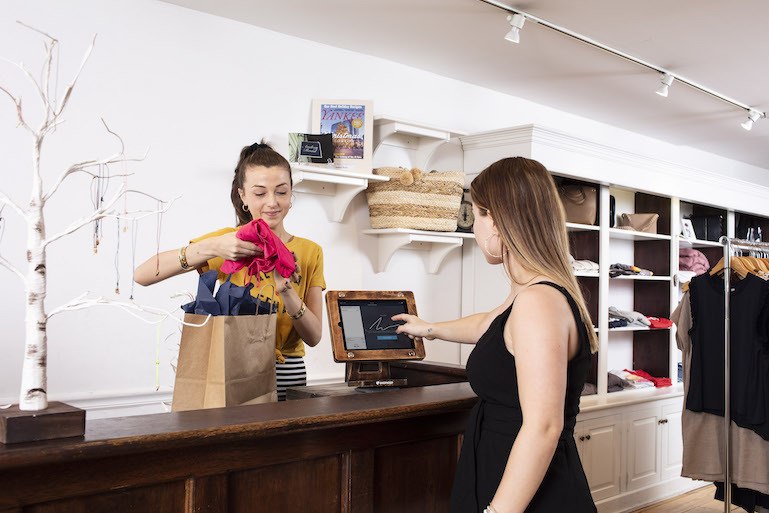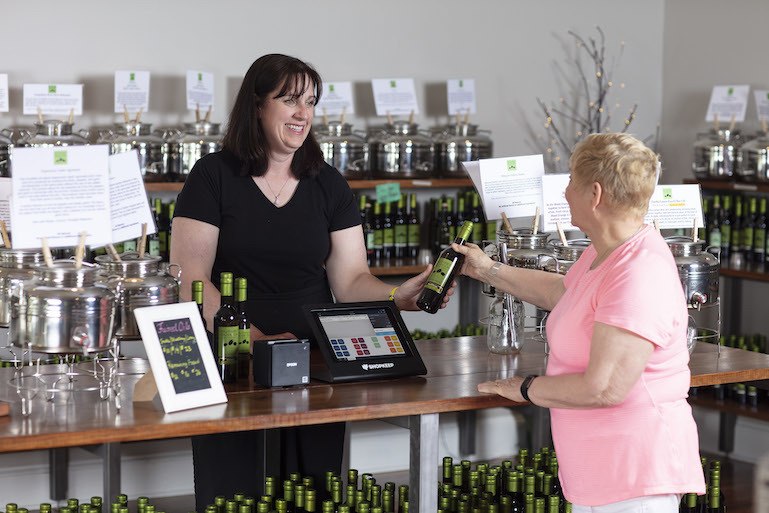
Your Short, Sweet Guide to Retail Software Solutions
As an independent retailer in a world of big-box stores like Amazon and Walmart, you need all the help you can get to compete. In this guide to retail software solutions, we’ll show you how this technology can help you operate efficiently and profitably.
In the interest of respecting your limited time as a busy retail business owner, we’ll make this as to-the-point as possible. We’ll explain the different categories of retail software solutions, cover the key features to look for, and recommend a few different vendors to research.
What are Retail Software Solutions?
“Retail software solutions” is an umbrella term that describes software applications designed to help retailers manage their businesses. While this might sound a little bit complicated, you likely already know about at least a few of these applications, because retail software solutions are commonly referred to as point of sale (POS) systems.
With that in mind, let’s take a look at the two major categories of POS systems.
On-Premise POS Systems
On-premise POS systems are the traditional or legacy variation of point of sale systems. They’ve been around for decades are what many experienced merchants picture when they hear POS.
You’ve almost certainly seen one of these solutions in your day-to-day life. They’re commonly used in larger department stores, grocery stores, and while not directly related to retail, you’ll also find them in many established restaurants.
Despite the multitude of industries that use them, there are several characteristics that are common across on-premise POS systems.
Locally Installed Software
An on-premise POS system gets its name from the fact that its software is installed on a server or computer that’s physically located within your business. Unlike other technology that you may be used to, you’ll need to be physically in your business in order to access your point of sale and any of its functionality. If you like to do some work from home each night, this can be a limiting factor.
Proprietary Hardware
Many of these solutions run on proprietary hardware that’s designed specifically for the POS system. In one way this can be good. Much like an iPhone or Macbook, when hardware and software are designed for one another, efficiencies and performance are gained.
On the other hand, proprietary hardware is often more expensive than commodity hardware. Not only does this make startup expenses higher, but it makes replacing components more expensive should you run into issues with your hardware.
High Cost
On-premise is the old model of business software and it has prices to match. It’s not uncommon to spend thousands of dollars on a single POS terminal (cost includes both hardware and software. Most of the time, you’ll also need to pay extra to get customer support. This could be a regular subscription fee for access to support, or a flat fee you pay to buy a block of support hours. Lastly, if you want to upgrade your POS software to the latest version, you’ll need to buy it.
Technical Complexity
As we mentioned earlier, on-premise POS software is usually very old software. Compared to modern small business software, it’s typically complex and outdated. This means it’s hard for your cashiers to use on a day-to-day basis. It’s also likely to suffer from more crashes and bugs than yours used to. Installing a new version of the software is also typically very complicated and may require assistance from a customer support team or a specialized technician.
Cloud-Based POS Software
“Cloud-based” is the second major category of POS software. This type of software has taken over as the dominant way that business software is delivered to the end-user. You will often find cloud-based software sold via the software-as-a-service business model. With this approach, the merchant pays a monthly or yearly subscription fee in exchange for access to the software as well as a few other major features.
It’s highly likely that you’ve come across this type of POS system as well. Cloud-based POS software typically runs on iPads or Android tablets, though some versions will also run on laptops and desktop computers. This type of software is most often used by independent retailers and small businesses with a retail component.
Now onto those major features we mentioned.
Unparalleled Accessibility
One of the most valuable aspects of cloud-based POS systems is the ability to access your POS from any internet-connected device. This means that if you want to do some work at home, check your inventory while meeting with a distributor, or monitor sales while away on vacation, you can.
Commodity Hardware
Another great thing about cloud-based POS systems is that they typically run on hardware that you can buy from Amazon or any electronics store. This helps retailers in two major ways. When you’re getting your system set up, you can shop around to find the best deals versus find yourself forced to buy whatever your vendor is selling. For example, Amazon often runs deep discounts on Apple’s iPad. Second, if you run into an issue where your device breaks, you can typically get it repaired or replaced for far less than a piece of proprietary hardware.
Lower Cost
Unlike on-premise POS systems, you typically pay for a cloud-based POS with a monthly or annual subscription payment. As a part of the subscription fee, you get access to the software, free software updates, managed security, and access to customer support. Many times vendors will offer a few different subscription packages or plans to choose from, with more expensive options offering the more powerful features that are needed by larger brands.
Reduced Complexity
As it’s become the dominant way that software is delivered, cloud-based POS systems feature all of the benefits of modern software. What does that mean for you? Namely, increase reliability and less complexity. Not only is the software easier to use, but irritating tasks like installing updates are handled for you automatically. It’s just like using an app on your phone, and it could get any easier.
Features You Need
Because of the lower cost, overall ease of use, and accessibility benefits, we recommend that most independent retailers and small business owners choose a cloud-based POS system. With that in mind, let’s look at the features you’re going to want out of your system. Understanding these tools, and how they can contribute to your success, will help you make a shortlist of vendors, and ultimately choose the right one for you.
Intuitive Register
The register is the customer and cashier facing component of your POS system. For a cloud-based solution, this will typically run on an iPad or Android tablet. The main quality you want to look for here is ease of use.
An easy to use register is going to help your cashiers ring up customers easily and quickly. Reducing wait times by providing fast, efficient service to your customers is a great way to keep your customers happy, encouraging repeat business.
Similarly, an intuitive register is easier to train your staff to use. This allows you to implement a new system more quickly, and get new hires up to speed fast. This reduces wasted time and helps you recoup the time and money you put into hiring more quickly than you could otherwise.

Powerful Inventory Management
Inventory management is one of the killer features offered by POS systems. Without it, you’re left managing inventory with spreadsheets, or worse, by hand. Even if you don’t sell a ton of products, managing stock by hand gets unwieldy fast.
With the right tools a POS system can help you:
- Track your current stock levels for everything you sell
- Manage inventory with variants, which is essential for clothing boutiques
- Show you what you need to reorder, what quantities you need to order, and tell you when to make the order
- Track profit margins per item to help you maintain profitability
- Calculate the total value of your inventory to assist with cash flow management
Inventory management tools are the kind of thing you use day-in and day-out. Moments gained from the right set of tools result in hours added back to your workweek.
SEE ALSO: Why Your POS System is the Best Inventory Management App
Detailed Reporting
Similar to inventory management, reporting and analytics are one of the top reasons to purchase a POS system. With these tools, you can gain a detailed understanding of your business and use that information to make smart, informed decisions.
You’ll want to ensure that your POS system has reports that cover all of the major areas of your business:
- Sales
- Employee performance
- Inventory
- Marketing
In addition to simply having these reports, you’ll also want to ensure that they’re configurable and filterable based on what’s most important to your business. For example, it’s often helpful to compare custom date ranges against one another or the sales performance of different locations.
Customer Marketing Tools
In addition to helping you run a more efficient business, the right POS system can also help you run a more profitable one with customer marketing tools. While a POS will never replace a dedicated marketing platform, it can give you a leg up over competition that’s using a lesser system, like a legacy POS or an electronic cash register.
Here’s what you should look for:
- The ability to collect email addresses to build your list
- Customer relationship management (CRM) tools for tracking customer preferences
- Functionality to send email receipts to build brand recognition
- Integrations with more powerful marketing tools like MailChimp for email marketing
Wrapping It Up
Now that you have a solid understanding of the different types of POS systems and the key features you need to look out for, you’re well on your way to picking the right retail software solution for your business.
Want to try ShopKeep for yourself?
Just answer a few easy questions.
Need help finding the right point of sale?
Just complete the form. We’ll call you right back to explain how ShopKeep can work for you.
Hit the ground running.Sprinting, in fact!
Read our free, comprehensive guide, Small Business 101, to learn all you need to know about starting a thriving business.

